The ruins of the ancient pre-Hispanic cities of Mesoamerica today constitute not only a valuable source of information on those civilizations but also an invaluable attraction for tourism, the engine of the economy of several countries. But in this dynamic there are some cultures and places that have focused attention, leaving others somewhat on the sidelines. Everyone wants to visit the Mayan and Mexica archaeological sites - if perhaps completed with Teotihuacán -, leaving in the background the Totonacas, Purépechas, Zapotecs... Well, there is still one more unknown, that of the so-called Teuchitlán Tradition and its Guachimontones settlement.
To analyze it, it is necessary to relocate geographically with respect to what is usual in Mexico, where the weight of the Mayan and Mexica heritage always inclines attention towards the Yucatan and the central valley. Guachimontones is in the state of Jalisco, which is located on the Pacific coast, with its capital in Guadalajara and one hour from it. Not even its inclusion by UNESCO in the World Heritage Site in 2004 it has served to make it familiar to us which, ironically, helps to protect it and make it easier for experts to study.
A good part of this ignorance regarding its existence is that, compared to places like Chichén Itzá, Uxmal, Cobá, Palenque or Tulum (not to mention Mexico City, the old Tenochtitlán), about which we generally have news from the 16th century and, in any case, were rediscovered in the 19th century, Guachimontones was not found until 1970 (from a documentary review of 1938) and excavations only began after 1996, which is why it has hardly been removed. to light a hundredth part and, consequently, few have heard of it.
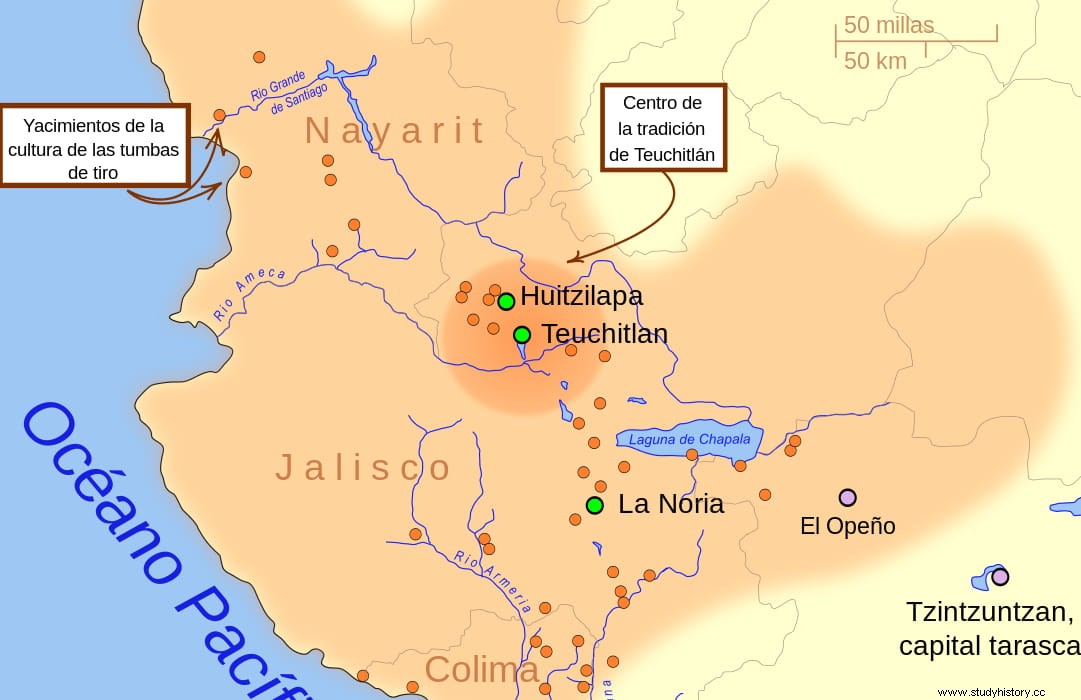
As we said before, this has its positive side because the deterioration of the ruins was already important, given that, for centuries, the locals plundered their stones in order to reuse them for their own constructions, as happened with the pyramids of Egypt. or many buildings of Ancient Rome during the Middle Ages. That is why Guachimontones was also included in the World Monuments Watch list. that the WWF (World Monuments Foundation) produces with monuments that are in danger for various reasons.
In reality, there are almost a thousand archaeological sites located in Jalisco and it is estimated that there could be twice as many. And that's counting only the big ones, whether they are cities or ceremonial centers, not the smaller towns. This reveals the importance of the place and forces us to go deeper into the culture that inhabited that environment. What is now the current state was populated, at different times, by Toltecs, Huachichiles, Caxcanes, Sayultecas, Tecuexes, Cocas... Also by the aforementioned Teuchitlán Tradition, which extended to neighboring Nayarit.
It was prior to many of those reviewed, with its beginning around the 4th century BC, surely related to the predecessor Tradition of the Tyre Tombs, a generic name given to a series of independent towns but with a similar cultural identity. However, its period of splendor arrived around the year 200 AD, during the Late Preclassic Period, to disappear in the Classic, around 900 AD. (or 600, the dates are uncertain), in such an abrupt way that it is considered that it must have been due to some external factor, probably related to the rise of the neighboring Tarascans.
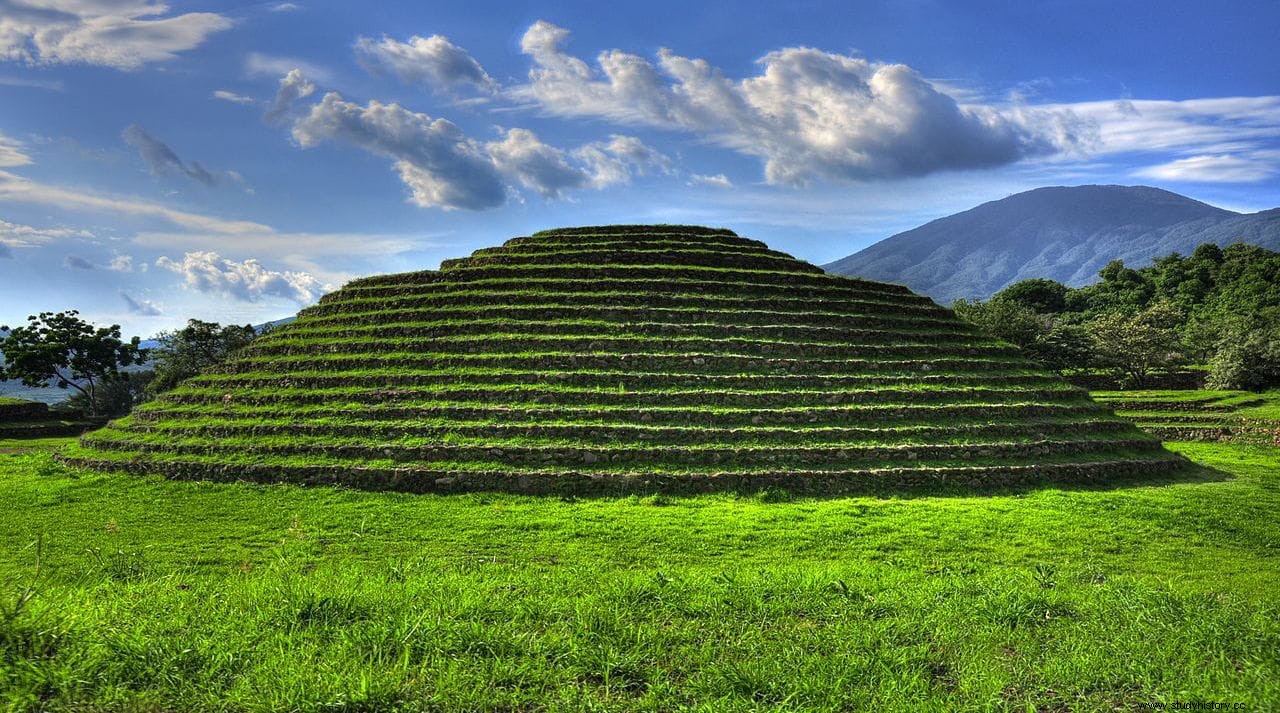
Teuchitlán is a word that comes from the Nahuatl teoztitlán ("place dedicated to the divine" or "place dedicated to the god Tenoch"), although some derive it from tepetitlan ("place next to the hills"). Today it gives its name to a modern municipality of just under ten thousand inhabitants, from which Guachimontones is barely a kilometer and a quarter away. Guachimontones (or Huachimontones) is a more recent term that combines the Nahuatl cuautli (tree) and chinamitli (muralla) with the Spanish pile, although another version replaces the first two with huaxe , a very abundant type of tree in the region.
There is no shortage of authors who disagree, at least partially. Phil Weigand, the late archaeologist who began the excavations in the mid-1990s with his wife Arcelia García (both from the Colegio de Michoacán), believes that, despite the etymology of the name, the language of that people was not Nahuatl origin, opting rather for totorame (a variety of Uto-Aztec cora, typical of Nayarit). What it does seem is that Guachimontón can be translated as "closed place", alluding to the unusual architectural constructions that characterize the site.
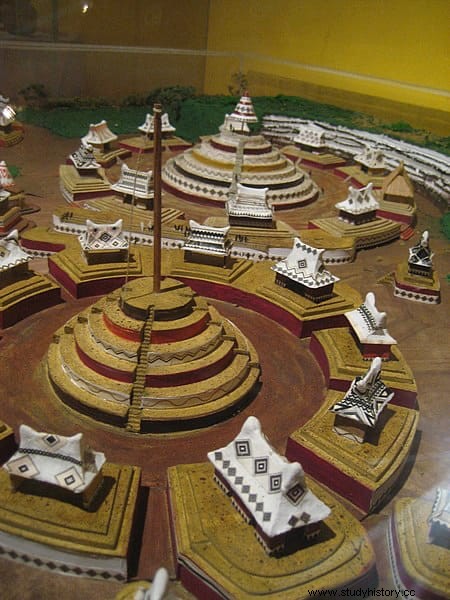
Unusual because they are made up of concentric circular groups of buildings, each one around a conical stepped pyramid, something unique in the world. Added to all this are the unique funerary structures known as shaft tombs, the whole constituting a specific style. It occupies about 90 hectares, which at its height must have been 24,000, although its center must have been on the Huachimontón hill, a little further north of the current site.
As in other places, these circular plazas were for the exclusive use of the social elite (governors and priests), since it was a rigidly stratified and decentralized society, as was the case in the rest of Mesoamerica. That the plazas were organized around the pyramids indicates that they were ceremonial places in which that structure (that of Circle 2 is 60 meters high and has 13 stepped terraces topped by another 4 that represented a calendar) was the temple, being Ehécatl the most important god of his pantheon.
Ehécatl was a divinity associated with the wind, like Quetzalcóatl (Toltec and Aztec (Edahi for the Otomi, Kukulkan for the Maya), with whom he was assimilated. He was considered one of those responsible for creation and was associated precisely with the circle because it it is infinite (it has no beginning or end), just like the air, which is why its temples often had that plan, which incidentally helped its circulation.One of the manifestations of worship of Ehécatl was that of the Voladores, in the one in which the priests climbed to the top of towering poles to drop down attached to a rope tied to their feet, turning while playing a musical instrument imitating a bird.

It is known that the tradition of the Voladores, which has survived until today in Mexico as a folk show, was part of Guachimontones because at the top of the pyramids there are holes as thick as those masts where they were inserted. But the pyramid, even being conical, is not the only structure that exists with reference to the rest of Mesoamerica; There are also, for example, the ball game courts, where that curious mixture of sports was developed (you had to try to pass a rubber ball through a stone hoop without touching it with your limbs), religious rite (the loser was sacrificed) and political-administrative game (territorial division, signing of agreements, etc).
In Guachimontones there is the largest known court, 111 meters long by 24 wide, although there are many more, each one with some of the functions explained above. Likewise, each square was surrounded by a stepped sidewalk. Between it and the center of the square rose up to a dozen stepped platforms, each topped by a residential building made of wood and clay, and in whose underground area funerary crypts were located. There were ten of these circular complexes plus another four rectangular plazas.
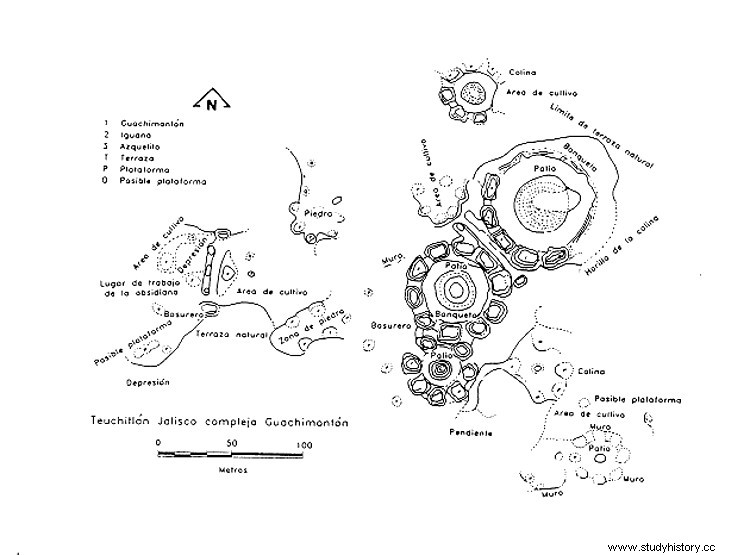
Likewise, gardens fed by springs gave the sidewalks a touch of beauty that amplified the other vegetal version, the agrarian one, formed by the chinampas and surrounding lands of a nearby lake, irrigated by systems similar to those of the Mayans of Calakmul, which gave three annual harvests, in principle sufficient to feed the estimated 25,000 inhabitants of the city during the period of greatest splendor (about 40,000 if the entire region is counted). Unfortunately, these systems were so good that farmers in later times reused them, causing irreparable losses in the archaeological record.
Evidently, the local economy extended to other sectors, such as the elaboration of tools and handicrafts with materials such as obsidian, copper, gold, silver and malachite. And that, despite everything, Teuchitlán was still a minor territory dependent on another more important one, the Etzatlan lordship, where the colimas or tecos lived, fierce warriors who would later repel an attempted Purépecha invasion and several Spanish expeditions until that were conquered by Gonzalo de Sandoval, one of the captains of Hernán Cortés.
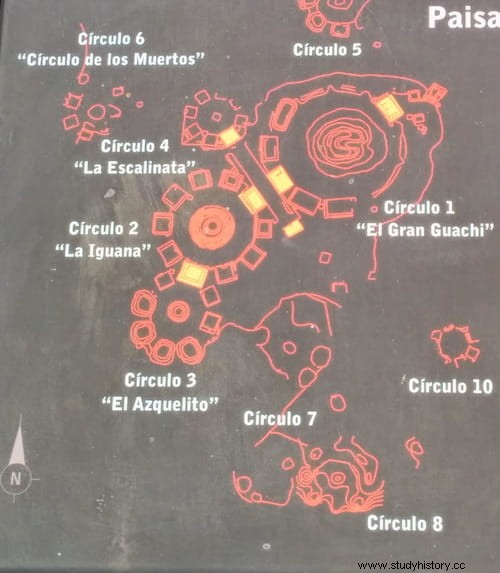
Circle 1, also called El Gran Guachi , is not the only remarkable one; the 2, baptized as La Iguana , second in size (105 meters in diameter and 360 meters in perimeter, with 10 platforms) and separated from the previous one by the long ballcourt, is also well preserved. It is intertwined through a common temple with the third, El Azquelite , something smaller. Along with all this, later architecture also appeared, from the Postclassic, with rectangular instead of circular layouts, more practical and indicative of the new times (although the temple of Ehécatl-Quetzacoátl in Tenochtitlán would also be built circular).
Although the number of tourists who come to Gauchimontones is far from the mass influx of the Yucatán or Teotihuacán, in 2012 an interpretation center was opened in situ (named after Phil Weigand) to report on both the city and the Teuchitlán Tradition, as well as the status of archaeological excavations. It includes a small museum with recovered pieces and guided tours.
Fonts
The Teuchitlan civilization (Phil Weigand and Chrispoher S. Beekman inLa Jornada )/Ancient Western Mexico. New perspectives on the pre-Hispanic past (VVAA)/Political Boundaries and Political Structure:the Limits of the Teuchitlan Tradition (Christopher S. Beekman)/Teuchitlán Archaeological Project (Phil Weigand and Efraín Cárdenas)/Prehispanic West Mexico. A Mesoamerican Culture Area (Eduardo Williams at FAMSI, Foundation for the Advancement of Mesoamerican Studies)/Wikipedia
